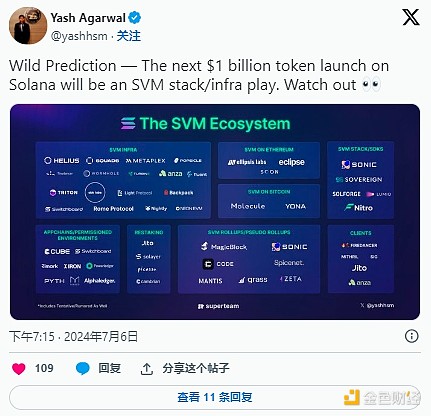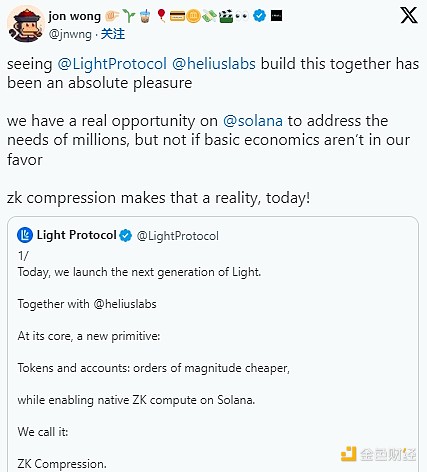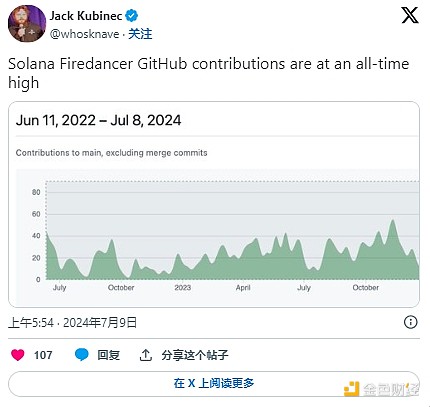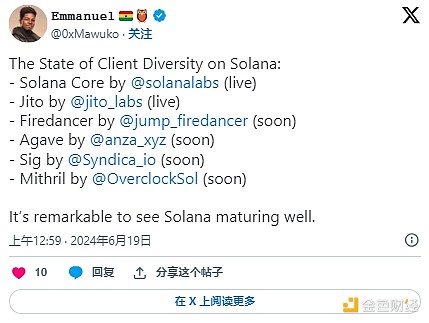Author: David C, Bankless; Translator: Baishui, Golden Finance
Solana has had a turbulent year.
With most investors’ attention focused on price action and the impact of the memecoin market on Solana, the most optimistic development for L1 is the actual progress the project has made.
In this article, we will dive into a range of different technologies being adopted and developed to advance blockchain, from a thriving L2 ecosystem to ZK compression to new validator clients, all of which could lead to a bright and lasting future for Solana.
Solana L2 and Rollups
While Solana’s 1.18.15 software update may mark a major improvement for the network thanks to a new central scheduler, it is by no means the only upgrade Solana needs to manage high transaction volume and scale as it continues to succeed.
Months of memecoin transaction congestion and an expected airdrop have tested Solana’s monolithic architecture, sparking debate over whether to remain monolithic or take a modular approach.
Solana’s monolithic design (all activity occurs on a single chain) has advantages such as fast transaction speeds and ease of composability, but as the chain matures, infrastructure costs rise. Earlier this year, we saw a lot of discussion about Solana’s need for L2s and Rollups to address rising costs and congestion.
Momentum continues to build for L2s and the Solana Virtual Machine (SVM) modularity as application chains and L2s develop in gaming, AI, banking, and trading. This is driven by scalability needs and the success of appchains like Pyth, which spun off mainnet to handle high-frequency price updates while maintaining an SVM to handle high transaction volumes.
Others are following Pyth’s lead, building appchains and Rollups with their own SVMs for specific use cases.
MagicBlock introduces Ephemeral Rollups on Solana for scalable, composable on-chain gaming.
Grass is a browser-based DePIN project that uses ZK proofs for data verification on its own L2, solving the AI data problem.
Zeta Markets, a perpetual DEX, plans to launch a Solana Rollup to improve its user experience, capital efficiency, and transaction speed.
Sonic recently launched its testnet and is building a modular SVM chain (Hypergrid) for games to deploy their own chains on Solana.
Iron Bank is developing the first institutional on-chain bank using SVM for high-performance, compliant fiat transactions.
Mantis is a Solana Rollup that provides chain-abstracted order flow, cross-chain interoperability, and native yields through Picasso Network’s Restaking Layer.

ZK Compression
In addition to L2s, Solana’s developer platform Helius and Solana’s ZK layer Light Protocol also introduced a technology called ZK compression to scale the network.
ZK compression aims to enhance scalability by addressing state bloat, the continued growth of data that each node must store. State bloat increases hardware requirements for full nodes and makes historical data expensive to maintain. As a result, network costs go up, decentralization decreases, and application interoperability becomes more difficult.
While ZK compression reduces data size like traditional file compression, it also optimizes how Solana stores its ledger data by grouping multiple accounts into a single, verifiable digest, called a Merkle root. This approach reduces storage costs while maintaining the security and integrity of the data. This happens at the RPC level, which facilitates communication between different parts of the network, rather than directly on Solana.
ZK compression can greatly improve Solana’s scalability. It can alleviate state bloat, reduce full node requirements, enhance historical state access, improve ledger efficiency, reduce transaction costs, and maintain decentralization.

New Node Clients
Solana is evolving to meet the high demands of blockchain performance and reliability. Two major developments are the new node clients Firedancer and Mithril. These aim to enhance Solana’s scalability, efficiency, and robustness through upgraded technology.
Firedancer
The upcoming Firedancer validator client, developed by trading firm Jump Crypto, aims to enhance Solana’s performance through modular architecture, low latency, and high throughput.
Firedancer is now live on testnet, let’s take a look at how it implements these improvements.
Modular Architecture and Fault Tolerance:Unlike traditional clients, Firedancer uses separate processes called “blocks”, each of which performs a specific function, such as processing a transaction or verifying a signature. This modular approach ensures that the failure of one block does not affect the entire system.
Advanced Networking and Data Handling:Firedancer uses a custom implementation to efficiently manage data flow, minimize memory allocations, and prevent congestion that can cause network outages. In addition, Firedancer exploits data parallelism to process large volumes of transactions with minimal latency.
Hardware Acceleration and Efficiency:By combining field-programmable gate arrays (FPGAs) and efficient hardware, Firedancer achieves amazing throughput and energy efficiency. FPGAs allow Firedancer to process up to 8M signatures per second.

Mithril
Written in Golang, a coding language that focuses on simplicity and developed by validator Overclock, Mithril is an upcoming new full node client that aims to reduce hardware requirements and increase accessibility for running Solana nodes, thereby enhancing scalability and decentralization.
The development of Mithril is divided into several milestones:
Rebuilding the SVM:The first milestone is nearly complete and involves rebuilding the SVM in Golang, rewriting all system operations and native programs, and ensuring thorough testing and bug-free.
Transaction Processing and Ledger Updates:The second milestone focuses on processing transactions and updating the Solana ledger. Mithril will implement a minimal RPC interface to improve interaction with the network and enhance infrastructure components to ensure proper operation.
System Optimization:The third milestone involves optimizing system performance and reducing resource consumption by upgrading the virtual machine and account database. This allows for faster execution of smart contracts and more efficient data management, making the system more scalable.
Upgraded Data Retrieval and Storage:The final milestone aims to improve data accessibility, resilience, and security by retrieving blockchain data from multiple sources, ensuring availability, building archival capabilities for historical data, using BitTorrent for fast and reliable data distribution, and using Filecoin to enhance security and durability.

Looking Forward
As Solana continues to grow and address the challenges brought on by high transaction volumes and network congestion, the latest software updates and the introduction of new technologies such as L2, ZK compression, and advanced node clients mark significant progress in Solana’s ability to handle its aspirational scale.
The future is bright for Solana, as the chain adapts its architecture to meet growing demand and paves the way for continued growth and advancement, making the network the preferred place to build.
 JinseFinance
JinseFinance
 JinseFinance
JinseFinance JinseFinance
JinseFinance JinseFinance
JinseFinance Olive
Olive Cheng Yuan
Cheng Yuan Coinlive
Coinlive  CharlieXYZ
CharlieXYZ Cointelegraph
Cointelegraph Cointelegraph
Cointelegraph Cointelegraph
Cointelegraph